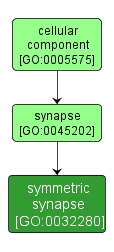GO TERM SUMMARY
|
| Name: |
symmetric synapse |
| Acc: |
GO:0032280 |
| Aspect: |
Cellular Component |
| Desc: |
A type of synapse occurring primarily on dendrite shafts and neuronal cell bodies. Symmetric synapses involve axons containing clusters of predominantly flattened or elongated vesicles and do not contain a prominent postsynaptic density. |
|

|
INTERACTIVE GO GRAPH
|














